- Visibility 140 Views
- Downloads 32 Downloads
- Permissions
- DOI 10.18231/j.jsas.2024.002
-
CrossMark
- Citation
Knowledge, attitudes, and practices regarding musculoskeletal disorders among industrial workers in a wind turbine industry in India
Abstract
Aim: To Study the Knowledge, Attitudes, and Practices Regarding Musculoskeletal Disorders Among Workers in a wind turbine industry in India.
Introduction: Musculoskeletal disorders (MSDs) affecting Industrial workers must be considered and addressed as a serious issue. Thus, it is important to incorporate ergonomics into clinical practice to prevent MSDs. In order to do screening and diagnosis of MSD's Among Industrial workers it is mandatory to know how much of awareness they have regarding MSD's and Ergonomic Hazards respectively as a preliminary study.
Materials and Methods: A cross-sectional study conducted in which the participants were interviewed to complete a validated four-section questionnaire (demographic data, knowledge, attitudes, and practice information related to ergonomics). The questionnaire was newly self-developed based on a literature review and was pilot tested after development.
Results: Out of the total workers who gave their responses for the questionnaire, about 80 percentage of the responses were positive among which the positive responses for knowledge-based questions, Attitude based questions and Practice based questions amounted to 73.16%, 83.12% and 88.36% respectively.
Discussion: The study aimed to investigate MSDs among industrial workers in the wind turbine industry in India. A validated questionnaire was used to collect and analyze workers' responses. The findings will enhance awareness and engagement regarding MSDs and ergonomic hazards, leading to effective interventions and a safer working environment. Addressing the identified gaps can improve worker well-being and productivity.
Introduction
Musculoskeletal disorders (MSDs) encompass a wide range of conditions affecting the muscles, tendons, joints, nerves, cartilage, and supporting structures in the upper and lower limbs, neck, and lower back. These disorders can be caused by prolonged exposure or sudden exertion of physical factors such as abnormal posture or vibration. A study conducted in the United States revealed that MSDs account for approximately 29-35% of all occupational injuries and diseases.
The causes of MSDs can be attributed to both physical and psychosocial factors in the workplace. Numerous risk factors, both occupational and non-occupational, have been identified in previous studies conducted worldwide among industrial workers. These risk factors can be broadly categorized into three main areas: knowledge, attitude and practices, work-related factors, and external factors.[1]
A Knowledge, Attitude, and Practices (KAP) survey is a questionnaire designed to assess respondents' understanding, attitudes, and behaviors related to a specific case study. Knowledge represents one's comprehension and perception, while attitude reflects one's inclination to act. Practices refer to observable individual actions in response to a stimulus. By conducting a KAP survey, gaps in knowledge can be identified, allowing for targeted improvements in information and education. Additionally, understanding attitudes and practices can shed light on why individuals choose certain behaviors over others.[2]
KAP surveys provide both quantitative and qualitative data, utilizing predefined questions presented in a standardized questionnaire format. These surveys not only capture KAP characteristics but also reveal individual perspectives on the issue at hand. However, it is important to note that these factors can sometimes lead to misconceptions and act as barriers to effective interventions.[3]
The objective of this study is to assess the awareness of MSD injuries among workers in an Indian wind turbine industry through a KAP survey. By gaining a comprehensive understanding of the KAP levels regarding MSDs, appropriate interventions and improvements can be implemented to enhance the safety of the working environment.[4]
Aims and Objectives
The primary aim of this research endeavor is to thoroughly investigate and examine the levels of knowledge, attitudes, and practices concerning musculoskeletal disorders (MSDs) among the workforce employed in the wind turbine industry located in India.
By conducting an in-depth exploration of these key factors, we aim to gain valuable insights into the understanding, perceptions, and behaviors of workers in relation to MSDs. This comprehensive study will provide a holistic understanding of the current state of knowledge, prevailing attitudes, and prevailing practices in the specific context of the wind turbine industry in India. The findings of this research will contribute to the existing body of knowledge on MSDs, enabling the formulation of targeted interventions and initiatives to improve the overall health and well-being of workers while simultaneously enhancing productivity and performance within the wind turbine industry.
Review of Literature
Sprain and strain injuries resulting from strenuous movement are a common occurrence in various industries, leading to a significant number of claims. A research study published in the American Journal of Industrial Medicine in 1989 reported that strain injuries accounted for the highest number of claims, with dislocations comprising approximately 31.9% of the total claimant cases.[5] Other frequently reported injuries included cuts, lacerations, punctures, scratches, and abrasions, which accounted for 14.9% of the claims, and chemical burns, which constituted 13.4%. The study further highlighted that Ohio recorded the highest proportion (73%) of claims related to sprain and strain injuries, making it the most frequent type of claim. Similarly, another study reported that approximately 35% of claims were attributed to sprain and strain pain.
Sprains refer to the stretching or tearing of ligaments, which are strong connective tissues connecting bones. On the other hand, strains involve injury to muscles or tendons, which are fibrous cords of tissue connecting muscles to bones. Strains often occur in the foot, leg (particularly the hamstring muscles), or back. Compared to sprains, strains are more likely to be a simple stretch in the muscle or tendon. Symptoms of strains include pain, muscle spasms, weakness, swelling, inflammation, and cramping. Typically, sprain and strain pain limits claimants from efficiently performing their daily job tasks. Consequently, this limitation reduces workers' productivity, which in turn may impact the Gross Domestic Product (GDP) of India as it strives to meet domestic and international demands.[6]
Occupational morbidity imposes a significant health and economic burden on individual workers, employers, and society as a whole. Kilbom et al. found that repetitive work can cause discomfort and pain in the neck, shoulders, and upper extremities. These symptoms were attributed to mechanical tissue overload resulting from repetitive movements, force requirements, and awkward postures. Repetitive work may also contribute to stress symptoms and musculoskeletal pain.
Boschman et al. investigated workers in the building construction industry and found that they reported complaints of back, knee, and shoulder/upper arm pain, with many workers attributing their complaints to work-related factors. Among workers, back and elbow complaints were most commonly reported during work, while lower arm/wrist and upper leg complaints were most prevalent among supervisors.[7]
Hanklang et al. examined the prevalence of musculoskeletal symptoms among building construction workers and found that 57.7% reported experiencing such symptoms, with the lower back and shoulders being the most commonly affected body parts (46.0%). Multiple logistic regression analysis indicated a significant association between prolonged work duration and musculoskeletal disorders. Similarly, our present study revealed a duration-response relationship, with longer work exposures leading to increased musculoskeletal complaints.
It is important to note that studies examining repetitive work as a potential risk factor for musculoskeletal disorders often consider other physical workplace factors concurrently. Repetitive work is not always the primary exposure factor but is evaluated alongside other relevant work factors. Other significant factors contributing to musculoskeletal disorders among industrial workers include vibration, posture, force applied, and exposure to predisposing risk factors.[8]
Therefore, our study aims to assess the level of awareness among industrial workers regarding musculoskeletal disorders, the role of lifestyle modifications in their prevention, and the attitudes of industrial workers towards musculoskeletal disorders and ergonomics. This information will serve as a basis for planning future interventions to educate industrial workers based on their existing knowledge of musculoskeletal disorders and ergonomics.
Methodology
To analyze the Knowledge, Attitudes, and Practices (KAP) levels regarding Musculoskeletal Disorders (MSDs) among wind turbine industrial workers from an employer perspective, a comprehensive instrument was developed in three stages. Firstly, an extensive literature search was conducted to identify existing KAP instruments related to MSDs in industrial settings. The findings were thoroughly reviewed, analyzed, and used as a guide to develop the items, scales, and response options for the new instrument. The wording and phrasing of the instrument were carefully modified in both English and Tamil languages to ensure ease of understanding for the participants.
Categorical responses were utilized to assess the participants' knowledge, attitudes, and practices, with scores categorized as positive (+ve) or negative (-ve). The knowledge section consisted of questions requiring agreement or disagreement, with agreement indicating a positive score and disagreement indicating a negative score. Similarly, the attitude and practices sections also utilized agree or disagree responses, corresponding to positive and negative scores, respectively. The questionnaire comprised a total of 35 questions, with 15 items assessing knowledge, 14 items evaluating attitudes, and 11 items focusing on practices.
Before the main data collection, a pilot test was conducted with 20 part-time students employed in various industries. This helped refine the questionnaire and ensure its clarity and relevance. Subsequently, the finalized questionnaire was distributed to 136 industrial workers in the wind turbine industry. The participants were provided with a detailed explanation of the study's purpose and were given the opportunity to seek clarification regarding any doubts they had while responding to the questionnaire. All their responses to individual items of the questionnaire were meticulously documented and subjected to thorough analysis.
The collected data was analyzed using the statistical software SPSS version 22. The proportion of respondents who answered each item correctly in the KAP questionnaire was calculated, indicating the good score and the corresponding percentage of correct responses.
Expanding on the word count, it is worth mentioning that the sample size of 136 participants was determined based on a confidence level of 80% and a desired confidence interval of 5%. This sample size was calculated with consideration for the finite population correction factor, assuming a population size of 1,000,000. The design effect (DEFF) was not applicable in this study, as it is typically used for cluster surveys.
In conclusion, the development and implementation of a robust KAP instrument allowed for the assessment of MSD-related knowledge, attitudes, and practices among wind turbine industrial workers. The findings from this study will contribute to a better understanding of the current KAP levels in the industry and inform targeted interventions and strategies to improve occupational health and well-being in relation to MSDs.
Statistics
Sample Size for Frequency in a Population
Population size (for finite population correction factor or fpc) (N): 1000000
Hypothesized % frequency of outcome factor the population (p):29%+/-5
Confidence limits as % of 100(absolute +/-%) (d): 5%
Sample Size(n) for Various Confidence Levels
Confidence Level (%): 80%
Sample Size: 136
Design effect (for cluster surveys-DEFF): 1
Results and Analysis
Among the entire population of workers who participated in the questionnaire, a significant proportion of approximately 80% provided positive responses. This indicates that the majority of respondents displayed favorable attitudes and knowledge towards musculoskeletal disorders (MSDs). Specifically, when examining the breakdown of positive responses by category, it was found that 73.16% of respondents showed a strong understanding of MSD-related knowledge-based questions. Furthermore, an encouraging 83.12% demonstrated positive attitudes towards MSDs, as reflected in their responses to attitude-based questions. When it came to actual practices related to MSD prevention and management, an impressive 88.36% of respondents exhibited favorable behaviors and practices. These findings suggest a generally high level of awareness and engagement among the workers in the wind turbine industry regarding MSDs and their associated aspects.
|
Demographic Variables |
Frequency |
Percentage |
|---|---|---|
|
Gender |
|
|
|
Male |
105 |
77.2 |
|
Female |
31 |
22.8 |
|
Age in years |
|
|
|
21 – 30 |
33 |
24.3 |
|
31 – 40 |
63 |
46.3 |
|
41 – 50 |
40 |
29.4 |
|
>50 |
- |
- |
The [Table 1] shows that with regard to gender of the industrial workers, 105(77.2%) were male and 31(22.8%) were female.
Regarding age of the industrial workers, 63(46.3%) were aged between 31 – 40 years, 40(29.4%) were aged between 41 – 50 years and 33(24.3%) were aged between 21 – 30 years.
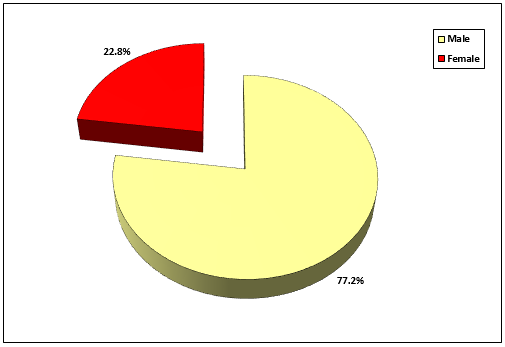
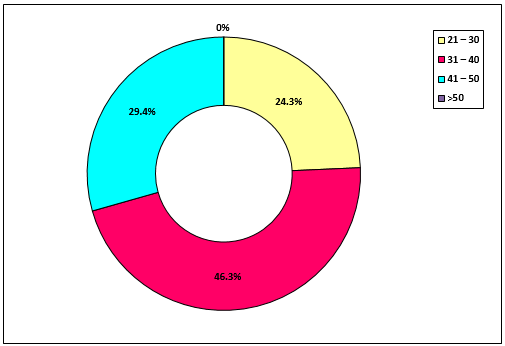
|
Level of Knowledge |
Frequency |
Percentage |
|
Inadequate (0 – 2) |
2 |
1.47 |
|
Moderately Adequate (3 – 5) |
11 |
8.09 |
|
Adequate (6 – 8) |
123 |
90.44 |
The [Table 2] shows that 123(90.44%) had adequate knowledge, 11(8.09%) had moderately adequate and 2(1.47%) had inadequate knowledge regarding musculoskeletal disorders among industrial workers.
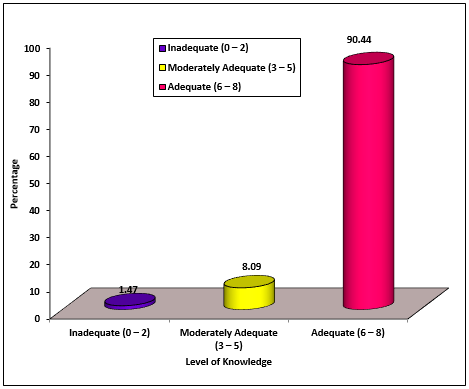
|
Level of Attitude |
Frequency |
Percentage |
|
Unfavourable (0 – 4) |
0 |
0 |
|
Moderately Favourable (5 – 9) |
53 |
38.97 |
|
Favourable (10 – 14) |
83 |
61.03 |
The [Table 3] shows that 83(61.03%) had moderately favourable attitude and 53(38.97%) had moderately favourable attitude regarding musculoskeletal disorders among industrial workers.
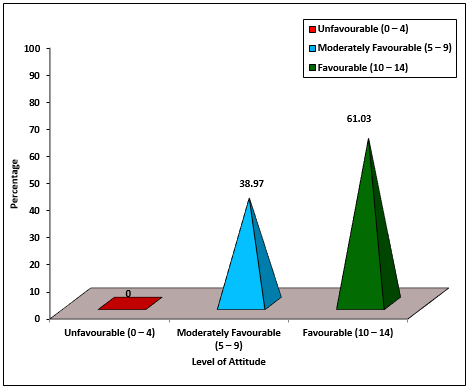
|
Level of Practice |
Frequency |
Percentage |
|
Poor (0 – 3) |
0 |
0 |
|
Moderate (4 – 7) |
13 |
9.56 |
|
Good (8 – 11) |
123 |
90.44 |
The [Table 4] shows that 123(90.44%) had good practice and 13(9.56%) had moderate practice regarding musculoskeletal disorders among industrial workers.
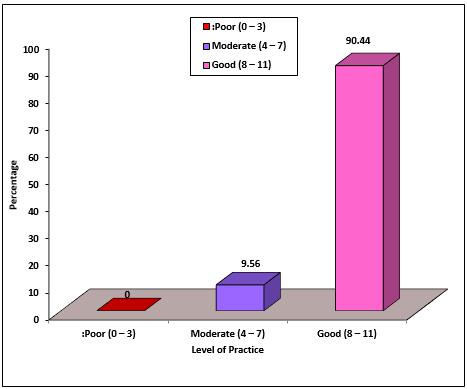
|
Variables |
Mean |
S.D. |
Karl Pearson’s Correlation ‘r’ value |
|
Knowledge |
7.01 |
1.27 |
r = 0.305 p=0.0001, S*** |
|
Attitude |
9.98 |
1.87 |
|
|
Knowledge |
7.01 |
1.27 |
r = 0.541 p=0.0001, S*** |
|
Practice |
9.74 |
1.47 |
|
|
Attitude |
9.98 |
1.87 |
r = 0.349 p=0.0001, S*** |
|
Practice |
9.74 |
1.47 |
The [Table 5] shows the mean score of knowledge was 7.01±1.27, attitude was 9.98±1.87 and practice was 9.74±1.47. The calculated Karl Pearson’s Correlation value of “r” between knowledge and attitude (r=0.305), between knowledge and practice (r=0.541) and between attitude and practice (r=0.349) shows a positive correlation which was found to be statistically significant at p<0.001 level. This clearly infers that when knowledge regarding musculoskeletal disorders among industrial workers increases then their attitude and practice towards it also increases.
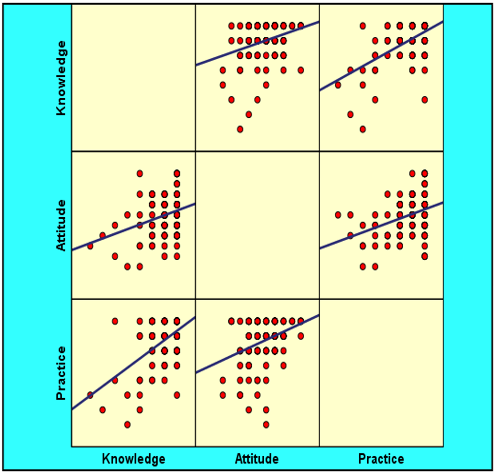
|
Demographic Variables |
Inadequate |
Moderately Adequate |
Adequate |
Chi-Square & p-value |
|||
|---|---|---|---|---|---|---|---|
|
F |
% |
F |
% |
F |
% |
||
|
Gender |
|
|
|
|
|
|
c2=1.016 d. f=2 p=0.602 N.S. |
|
Male |
1 |
0.7 |
8 |
2.2 |
27 |
19.9 |
|
|
Female |
1 |
0.7 |
3 |
5.9 |
96 |
70.6 |
|
|
Age in years |
|
|
|
|
|
|
c2=1.187 d.f=4 p=0.880 N.S. |
|
21 – 30 |
0 |
0 |
2 |
1.5 |
31 |
22.8 |
|
|
31 – 40 |
1 |
0.7 |
6 |
4.4 |
56 |
41.2 |
|
|
41 – 50 |
1 |
0.7 |
3 |
2.2 |
36 |
26.5 |
|
|
>50 |
- |
- |
- |
- |
- |
- |
The [Table 6] shows that the demographic variables gender and age of the industrial workers did not show statistically significant association with level of knowledge regarding musculoskeletal disorders among industrial workers.
|
Demographic Variables |
Unfavourable |
Moderately Favourable |
Favourable |
Chi-Square & p-value |
|||
|---|---|---|---|---|---|---|---|
|
F |
% |
F |
% |
F |
% |
||
|
Gender |
|
|
|
|
|
|
c2=4.251 d.f=1 p=0.039 S* |
|
Male |
- |
- |
36 |
26.5 |
69 |
50.7 |
|
|
Female |
- |
- |
17 |
12.5 |
14 |
10.3 |
|
|
Age in years |
|
|
|
|
|
|
c2=4.450 d.f=2 p=0.108 N.S |
|
21 – 30 |
- |
- |
17 |
12.5 |
16 |
11.8 |
|
|
31 – 40 |
- |
- |
19 |
14.0 |
44 |
32.4 |
|
|
41 – 50 |
- |
- |
17 |
12.5 |
23 |
16.9 |
|
|
>50 |
- |
- |
- |
- |
- |
- |
The [Table 7] shows that the demographic variable gender (c2=4.251, p=0.030) had statistically significant association with level of attitude regarding musculoskeletal disorders among industrial workers at p<0.05 level and the demographic variable age of the industrial workers did not show statistically significant association with level of attitude regarding musculoskeletal disorders among industrial workers.
|
Demographic Variables |
Poor |
Moderate |
Good |
Chi-Square & p-value |
|||
|---|---|---|---|---|---|---|---|
|
F |
% |
F |
% |
F |
% |
||
|
Gender |
|
|
|
|
|
|
c2=2.005 d.f=1 p=0.157 N.S |
|
Male |
- |
- |
8 |
5.9 |
97 |
71.3 |
|
|
Female |
- |
- |
5 |
3.7 |
26 |
19.1 |
|
|
Age in years |
|
|
|
|
|
|
c2=0.380 d.f=2 p=0.827 N.S |
|
21 – 30 |
- |
- |
3 |
2.2 |
30 |
22.1 |
|
|
31 – 40 |
- |
- |
7 |
5.1 |
56 |
41.2 |
|
|
41 – 50 |
- |
- |
3 |
2.2 |
37 |
27.2 |
|
|
>50 |
- |
- |
- |
- |
- |
- |
The [Table 8] shows that the demographic variables gender and age of the industrial workers did not show statistically significant association with level of practice regarding musculoskeletal disorders among industrial workers.
|
KAP Questionnaire Responses |
Agree |
Disagree |
|
1. Musculoskeletal disorder is a disorder that affects body movement or the musculoskeletal system of our body |
99.26 |
0.74 |
|
2. Musculoskeletal disorders occur when the body's physical ability is higher than mechanical workload |
84.56 |
15.44 |
|
3. Productivity may decrease due to Musculoskeletal disorders |
83.09 |
16.91 |
|
4. Musculoskeletal disorders may affect morale and work ethics |
70.59 |
29.41 |
|
5. Employee will recover to normal if no longer exposed to the risk factors |
85.93 |
14.07 |
|
6. Employee is responsible for knowing the risks and symptoms of musculoskeletal disorders by himself |
61.76 |
38.24 |
|
7. I assign work to employee according to their physical abilities |
86.76 |
13.24 |
|
8. There is good communication here about musculoskeletal disorders and safety issues which influence works |
75 |
25 |
|
9. Changes aimed to reduce Musculoskeletal disorders are probably to be successful |
87.5 |
12.5 |
|
10. I am not concerned about Musculoskeletal disorders early treatment because it may get cured by itself |
14.81 |
85.19 |
|
11. I don't need to change the way employee work due to Musculoskeletal disorders related injuries |
19.26 |
80.74 |
|
12. Some health and safety rules are not really effective |
82.22 |
17.78 |
|
13. My knowledge regarding the prevention and detection of Musculoskeletal disorders is updated and sufficient |
81.48 |
18.52 |
|
14. Training and education on minimizing the risk of Musculoskeletal disorders should be done periodically |
90.44 |
9.56 |
|
15. Advantage of actions to reduce Musculoskeletal disorders are likely to exceed the costs |
74.81 |
25.19 |
|
16. I'm sure it's only a matter of time before employee develop Musculoskeletal disorders from work |
75.74 |
24.26 |
|
17. I consider prevention of Musculoskeletal disorders and safety are as important as production works |
93.38 |
6.62 |
|
18. Some health and safety rules and procedures don't need to be obeyed to get the job done safely |
54.07 |
45.93 |
|
19. Periodic workplace safety inspection helps in prevention |
93.38 |
6.62 |
|
20. I always give sufficient time to get the job done safely |
91.85 |
8.15 |
|
21. Regular body and musculoskeletal system health screening helps in prevention |
91.91 |
8.09 |
|
22. Employer check, advice, and correct employee on bad posture helps in prevention |
94.12 |
5.88 |
|
23. Often study on Musculoskeletal disorders related information helps in prevention |
91.91 |
8.09 |
|
24. Seminars, courses or talks on Musculoskeletal disorders at workplace help in prevention |
63.24 |
36.76 |
|
25. Training on health and safety related issues for employee helps in prevention |
81.62 |
18.38 |
|
26. Short breaks from work help in prevention |
94.85 |
5.15 |
|
27. Light exercise session during working hours helps in prevention |
95.59 |
4.41 |
|
28. Encouraging employees to report unsafe conditions at workplace helps in prevention |
91.91 |
8.09 |
|
29. Informing the management on important Musculoskeletal disorders and safety issues helps in prevention |
90.44 |
9.56 |
|
30. Involved in ongoing evaluation of Musculoskeletal disorders and safety issues helps in prevention |
88.97 |
11.03 |
|
31. Repetitive motion is a risk factor |
87.5 |
12.5 |
|
32. Prior history of broken bones is a risk factor |
88.97 |
11.03 |
|
33. Inadequate break time is a risk factor |
69.63 |
30.37 |
|
34. Awkward body posture is a risk factor |
94.12 |
5.88 |
Discussion
Musculoskeletal disorders (MSDs) are prevalent among employees in various industries and can have a significant impact on their health and well-being. Having adequate knowledge about MSDs is crucial for employees to understand the risks involved and take preventive measures. [9] This essay aims to explore the importance of knowledge regarding musculoskeletal disorders among employees and its implications for workplace health and safety.[10]
Firstly, understanding the nature of musculoskeletal disorders is essential. MSDs encompass a range of conditions that affect the muscles, bones, tendons, ligaments, and other supporting structures of the body. [11] These disorders can result from various factors, including repetitive movements, poor posture, excessive force, and inadequate ergonomics. By having knowledge about the causes and risk factors associated with MSDs, employees can identify potential hazards in their work environment and make informed decisions to prevent or minimize the onset of such disorders.[12]
Furthermore, awareness of the signs and symptoms of MSDs is crucial. Common symptoms include pain, stiffness, swelling, weakness, and limited range of motion in the affected body parts. Recognizing these symptoms early on allows employees to seek timely medical attention and adopt appropriate self-care measures. Moreover, being aware of the potential long-term consequences of untreated or improperly managed MSDs can motivate employees to prioritize their musculoskeletal health and take necessary steps to mitigate the risks.[13]
Additionally, knowledge about ergonomic principles and best practices is essential in preventing MSDs. Ergonomics focuses on designing workstations, tools, and equipment in a way that optimizes human performance while reducing the risk of injury or discomfort. Employees who are aware of proper ergonomic techniques can make adjustments to their workstations, use ergonomic tools, and practice correct posture and body mechanics. This knowledge empowers employees to create a safer and healthier work environment for themselves and their colleagues.[14]
Another important aspect is understanding the importance of regular physical activity, exercise, and stretching in preventing MSDs. Engaging in physical activity and incorporating stretching exercises can help improve muscle strength, flexibility, and overall musculoskeletal health. [15] Educating employees about the benefits of exercise and providing guidance on appropriate exercises and techniques can motivate them to incorporate physical activity into their daily routines, thereby reducing the risk of MSDs.
Furthermore, raising awareness about available resources and support systems is vital. Employers can provide educational materials, training programs, and access to occupational health professionals who can offer guidance and support in preventing and managing MSDs.[16] Employees should be aware of these resources and encouraged to seek assistance whenever necessary. A culture that promotes open communication about musculoskeletal health and encourages reporting of any discomfort or early signs of MSDs can contribute to early intervention and better outcomes for employees.[17]
In conclusion, having adequate knowledge about musculoskeletal disorders is crucial for employees in maintaining their health and well-being. Awareness of the causes, risk factors, symptoms, preventive measures, and available resources empowers employees to take proactive steps in preventing and managing MSDs.[18] Employers play a significant role in providing educational opportunities, promoting a culture of safety, and implementing ergonomic practices in the workplace. By fostering a knowledgeable workforce, organizations can enhance employee health, productivity, and overall job satisfaction.
Conclusion
In conclusion, this study aimed to assess the knowledge, attitudes, and practices regarding musculoskeletal disorders (MSDs) among workers in a wind turbine industry in India. The findings of this study provide valuable insights into the awareness and understanding of ergonomic hazards and MSDs among industrial workers.
The results indicated that there is a need for improvement in the knowledge of industrial workers regarding MSDs and ergonomic hazards. This highlights the importance of incorporating ergonomics into clinical practice and promoting awareness about the potential risks and preventive measures associated with MSDs.
The attitudes of the industrial workers towards MSDs were generally positive, suggesting a willingness to adopt preventive measures. However, there is still a gap between attitude and actual practice, indicating a need for interventions to bridge this gap and promote the implementation of ergonomic practices in the workplace.
The study underscores the significance of conducting regular training programs and workshops to enhance the knowledge and awareness of industrial workers regarding MSDs and ergonomics. By addressing the gaps identified in this study, it is possible to develop targeted interventions and strategies to reduce the incidence of MSDs and improve the overall well-being of industrial workers.
It is important to note that this study had some limitations, such as a relatively small sample size and the use of self-reported data, which may introduce response bias. Future research with larger sample sizes and objective measurements of ergonomic practices would provide more robust evidence.
Overall, this study highlights the need for ongoing efforts to educate and empower industrial workers in the wind turbine industry in India regarding MSDs and ergonomics. By promoting a culture of safety, raising awareness, and implementing effective preventive measures, it is possible to mitigate the risks associated with MSDs and improve the overall occupational health and well-being of industrial worker.
Source of Funding
None.
Conflict of Interest
None.
References
- . Epidemiology of Musculoskeletal Disorders and Workplace Factors | SpringerLink. . 2023. [Google Scholar]
- . . Handbook of musculoskeletal pain and disability disorders in the. 2015. [Google Scholar]
- Gatchel RJ, Schultz IZ. . Handbook of musculoskeletal pain and disability disorders in the workplace. . [Google Scholar]
- Melhorn JM, Wilkinson L, Riggs JD. Management of musculoskeletal pain in the workplace. J Occup Environ Med. 2001;43(1):83-93. [Google Scholar]
- Abidin N, Rohani M, Zein M, Nordin N. Financial Impact and Causes of Chronic Musculoskeletal Disease Cases in Malaysia Based on Social Security Organization of Malaysia Claims Record. Int J Eng Technol. 2018;7(3):23-7. [Google Scholar]
- Bernard B, Putz-Anderson V, Fine FL, Grant K. Musculoskeletal Disorders and Workplace Factors A Critical Review of Epidemiologic Evidence for Work-Related Musculoskeletal Disorders of the Neck, Upper Extremity, and Low Back. . 1997. [Google Scholar]
- Boschman J, Molen HVD, Sluiter J, Frings-Dresen M. Musculoskeletal disorders among construction workers: A one-year follow-up study. BMC Musculoskelet Disord. 2012;13. [Google Scholar] [Crossref]
- Nordin A, Rohani J, Abidin N, Zein R, Zuki A. Knowledge, attitude and practices of musculoskeletal disorder injuries from Malaysian industries employers’ perspective. Int J Eng Technol. 2018;7(3):28-31. [Google Scholar]
- Melhorn JM. Successful management of musculoskeletal disorders. Hum Ecol Risk Assess. 2001;7(7):1801-11. [Google Scholar]
- Melhorn J. The impact of workplace screening on the occurrence of cumulative trauma disorders and workers’ compensation claims. J Occup Environ Med. 1999;41(2):84-92. [Google Scholar]
- Melhorn J, Wilkinson L, Gardner P, Horst W, Silkey B. An outcomes study of an occupational medicine intervention program for the reduction of musculoskeletal disorders and cumulative trauma disorders in the workplace. J Occup Environ Med. 1999;41(10):833-79. [Google Scholar]
- Gisolf J, Clay F, Mcclure C. Predictors of sustained return to work after work-related injury or disease: Insights from workers’ compensation claims records. J Occup Rehabil. 2012;22(3):283-91. [Google Scholar]
- Egilman D, Punnett L, Hjelm E, Welch L. Evidence for work-related musculoskeletal disorders. Am Coll Occup Environ Med. 1996;38(11). [Google Scholar]
- Brady W, Bass J, Moser R, Anstadt G, Loeppke R, Leopold R. Defining total corporate health and safety costs - Significance and impact. J Occup Environ Med. 1997;39(3):224-55. [Google Scholar]
- Gross D, Battié M. Work-related recovery expectations and the prognosis of chronic low back pain within a workers’ compensation setting. J Occup Environ Med. 2005;47(4):428-61. [Google Scholar]
- Gatchel R, Schultz I. . Handbook of Musculoskeletal Pain and Disability Disorders in the Workplace. 2023. [Google Scholar]
- Melhorn J. Epidemiology of Musculoskeletal Disorders and Workplace Factors. . 2014. [Google Scholar]
- Meo S, Alsaaran Z, Alshehri M, Khashougji M, Almeterk A, Almutairi S. Work-related musculoskeletal symptoms among building construction workers in Riyadh, Saudi Arabia. Pak J Med Sci. 2013;29(6):1394-9. [Google Scholar]
How to Cite This Article
Vancouver
Ramanujam A, Janakapriya . Knowledge, attitudes, and practices regarding musculoskeletal disorders among industrial workers in a wind turbine industry in India [Internet]. IP J Surg Allied Sci. 2024 [cited 2025 Sep 18];6(1):5-13. Available from: https://doi.org/10.18231/j.jsas.2024.002
APA
Ramanujam, A., Janakapriya, (2024). Knowledge, attitudes, and practices regarding musculoskeletal disorders among industrial workers in a wind turbine industry in India. IP J Surg Allied Sci, 6(1), 5-13. https://doi.org/10.18231/j.jsas.2024.002
MLA
Ramanujam, Ashok, Janakapriya, . "Knowledge, attitudes, and practices regarding musculoskeletal disorders among industrial workers in a wind turbine industry in India." IP J Surg Allied Sci, vol. 6, no. 1, 2024, pp. 5-13. https://doi.org/10.18231/j.jsas.2024.002
Chicago
Ramanujam, A., Janakapriya, . "Knowledge, attitudes, and practices regarding musculoskeletal disorders among industrial workers in a wind turbine industry in India." IP J Surg Allied Sci 6, no. 1 (2024): 5-13. https://doi.org/10.18231/j.jsas.2024.002
